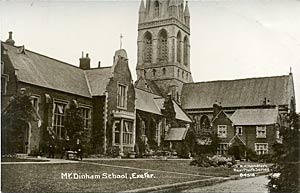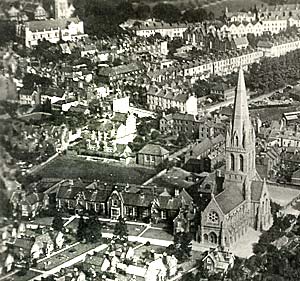
Episcopal Secondary Modern School - Mount Dinham
Page added 24th June 2010
Tucked away to the north-west of St Michael's Church, Mount Dinham, can be found a long Victorian building of two storeys that was once the Episcopal Secondary Modern School. The school, for a secondary modern, had a surprisingly long lineage, stretching back to 1709.
On the 16th June 1709, a meeting was called by Bishop Offspring Blackall, of the Dean and Ministers of the City Parishes, the Mayor, Recorder and other interested parties, at the Guildhall. The meeting was addressed to prospective "Subscribers to the Erecting Charity Schools within the City of Exon", and a Charity was founded to support the schools. At that time, most schools were supported by the church and were required to teach the bible. The plans progressed to a point that a Master was appointed, at £30 per year, for the boys school, in Paul Street and suitable rooms in his house were used as a temporary school, while a second boys' school would be opened, also in Paul Street.
For the girls, rooms were rented at the Blue Maids Hospital, Mary Arches Street, and a Mistress appointed on an annual salary of £25; the house, according to Jenkins had a 'battlemented' roof. Aged between 7 to 12, the boys were taught to read the Bible and Catechism, write, and do arithmetic. The girls did not follow such an academic curriculum, not learning arithmetic and writing, but were taught to knit and sew. The three schools, each accommodating 40 pupils, opened in September 1709. A second girls' school was opened during March 1812, in a house close to St Mary Arches Church. Each of the four schools provided their pupils with a uniform in its own distinctive colour. The schools were funded by the trustees subscribing £3 per year, plus the income from a property in Waterbeer Street that was left as a bequest for the schools. Over the years, sums of money were left to the charity schools, most notably, in 1712 the goldsmith, Mr William Eakins left £50 per annum to instruct the boys in mathematics, especially navigation, £200 from Mr Nathaniel Rowland, a merchant in 1713 for the education of poor children and in 1721, Richard Sandford left £300 for the purchase of an estate to produce an income for the schools.
The boys move to Waterbeer Street
In 1765, a gift of £90 allowed the Waterbeer Street premises to be refurbished, and the two boys' schools in Paul Street moved in. The school was adjoining Samuel Kingdon's warehouse and was "... a large ancient roomy house, bequeathed to the charity schools, and now appropriated as habitations for the two Schoolmasters, with school-rooms for the boys." - Jenkins.
Henry Blackall, a descendent of the venerable Bishop became involved in the Society for Promoting Education for the Poor in Devon from 1811, and the Charity Schools from 1813. He served as Chairman and Treasurer until his death in 1845, and was an important influence on the running of the Episcopal Schools. Other prominent Trustees during the 19th Century would include John Dinham and Dr Thomas Shapter. An advert for an assistant school mistress in 1818 stipulated that she must not be "... more than 35 years of age, and whose character and principles will not bear the strictest investigation."
Time rolled by until 1816, when a proposal was made to replace the four schools with purpose built premises. An advert placed in the Flying Post during 1816 gave notice that plans were being drawn up to build a new school in Upper Paul Street. Detailed accounts were printed showing a turnover of £1299 3s 2½d with a balance of £221 9s 5d. In addition, 123 subscribers were listed, subscribing amounts ranging from half a guinea to £20. It was also noted that the school roll at that time was 230 boys and girls.
The school moves again
By 1821, a new school was constructed in Upper Paul Street, behind the modern Pitcher and Piano, whose own site wasitself, a court that gave access to the upper school room. It was a two storey building with the boys classrooms on the upper floor, and houses for the Master and Mistress; it opened during midsummer 1818. The old Waterbeer Street premises were sold in 1827 for £553 Samuel Kingdon, for a new foundry, after his old foundry had burnt down the year before. By 1823, the Upper Paul Street accommodation was proving to be inadequate for the growing school and £500 used from a £5,000 legacy from Mr Worth, to enlarge the school to take 300 pupils. Through the 19th Century, social attitudes were changing, and by 1850 all the girls were being taught to write and to do arithmetic.
The growth of expectations, led to a need for better facilities, and on 12th May 1860, a notice of intention to sell the school was announced in the Flying Post, for bids exceeding £2,450. John Dinham offered a site on the 21st July 1860 at Mount Dinham that had been a nursery garden; he intended to also build almshouse to the west of the school site and also reserve land to the south for a church or chapel. The Victorians worked quickly, once they had made a decision, and it was announced that the foundation stone had been laid on the 17th April 1861 by the Mayor of Exeter. The children sang the National Anthem and gave three cheers for the Mayor and John Dinham. Strangely the Flying Post reported that the inscription on the foundation stone stated that it "... was laid by the Right Worshipful Mayor of Exeter, Frederick Franklyn Esq." The official list of Exeter Mayors states that the Mayor was Thomas E Drake that year.
John Dinham's land
By 1861 a school with houses for two teachers was constructed and occupied on the 21st January 1862. The cost was £4,000 for two teaching rooms, each 100ft by 20ft, which were divided internally for 340 boys, girls and infants. The layout was single storey, but with a generous internal ceiling height. The same year the old Blue Maids School in Mary Arches Street was closed, and sold, and a portion of the Blue Maids Charity funds allocated to educate 25 to 30 Blue Maids pupils at the new Episcopal School. The Blue Maids continued to be taught at the school until 1879 when the Girls' Middle School, later Bishop Blackall School was opened. In May 1875, the administration of the various charity schools in the city changed, and the board of trustees replaced with a Governing Board. This reorganisation saw the Middle (Bishop Blackall) and Modern Girls' (Maynards) Schools founded.
The issuing of school clothing was curtailed in 1876, and the fee structure changed from parents paying 2d per week per child, to a quarterly fee of 3/6 to 4/6 according to standards; the number of pupils attending the Episcopal School dropped because of the change in fees.
The boys and girls Episcopal Schools became Voluntary Aided Schools after the 1902 Education Act, being partly funded by Government. In 1933, the two schools in one building, became a Senior Boys and Senior Girls' School for the 11 to 14 age group. It became necessary to increase the accommodation for the school, and between August 1936 and August 1938, while the pupils were taught in temporary accommodation at the Institute for Blind, the old Exe Street School and St David's School, the building was altered. The 1861 foresight of incorporating high ceilings into the original design was utilised and a first floor inserted into the building, to provide accommodation for a boys and a girls school, each of 320 pupils, at a cost of £12,000.
The evacuees
On the 13th June 1940, as the country waited for the expected German invasion, the school was closed in order to take in evacuees from London. Twelve days later, the school re-opened, the classes reformed to accommodate the evacuees and three extra school masters from London were employed. The May 1942 bombing of the city did not damage the school, but it was closed and opened as a feeding station during the aftermath of the raid. The two schools were re-designated as Secondary Modern Schools after the 1944 Education Act.
In 1964 the schools were amalgamated for the first, and last time, into a single, mixed Episcopal Secondary Modern School. However, this state did not last long, as the building was no longer considered to be adequate and in the City wide reorganisation of secondary education in 1972, the Episcopal Secondary Modern School was closed down, and the buildings taken over by Exeter College.
The Episcopal School was attended by a young William George Hoskins during the First World War, before he gained a scholarship to Heles, becoming a historian of national importance. Hoskins returned to the school as guest of honour to distribute prizes, in July 1959. Peter Thomas of the Isca Photographic Collection is also a former pupil of the school.
Sources: History of Exeter, Second Edition, 1841 by Alexander Jenkins, Magna Britannica, 1814, by Daniel Lyson, Historical Notes on Devon Schools, 1989 by Robert Bovett, published by Devon County Council, Reminiscences of Exeter Fifty Years Since by James Cossins, 1877, the school logbook and Trewman's Exeter Flying Post.
 The Episcopal School and St Michael's Church.
The Episcopal School and St Michael's Church.
 The Episcopal School to the left of the church.
The Episcopal School to the left of the church.
Masters in the 19th Century
Mr T R Pinder up to 1852
Mr Miller from 1852 - died 1883 aged 57
Mr W S Pincott 1889
Mistresses in the 19th Century
Miss Dundridge 1837 to 1844
Mary Ann Langdon from 1844
Miss Sobey 1885
Esther Yeo 1899
│ Top of Page │